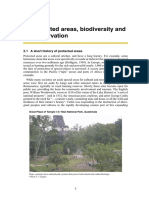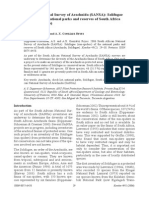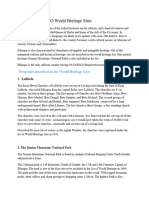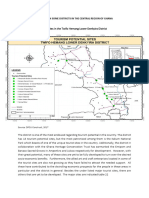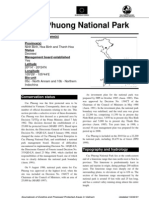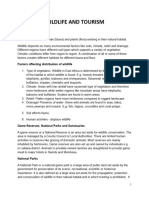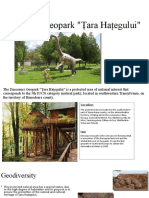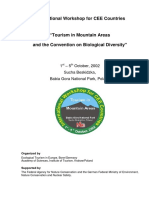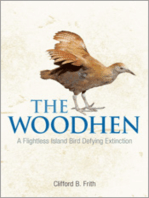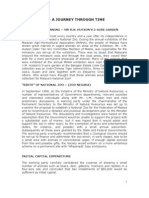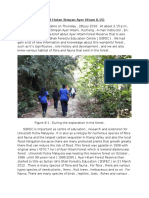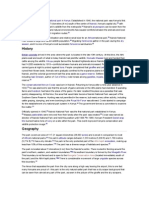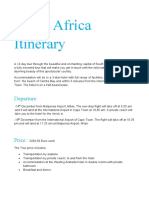Beruflich Dokumente
Kultur Dokumente
Etosha National Park
Hochgeladen von
catalinatorreCopyright
Verfügbare Formate
Dieses Dokument teilen
Dokument teilen oder einbetten
Stufen Sie dieses Dokument als nützlich ein?
Sind diese Inhalte unangemessen?
Dieses Dokument meldenCopyright:
Verfügbare Formate
Etosha National Park
Hochgeladen von
catalinatorreCopyright:
Verfügbare Formate
8/28/14 7:55 PM Etosha National Park - Wikipedia, the free encyclopedia
Page 1 of 12 http://en.wikipedia.org/wiki/Etosha_National_Park
Etosha National Park
IUCN category II (national park)
Animals at the Nebrownii waterhole
Map of show location in Namibia
Location Namibia
Coordinates 1856!43"S 1553!52"E
Area 22,270 square kilometres
(8,600 sq mi)
Established March 22, 1907
Visitors 200000 (in 2010)
Governing body Ministry of Environment and
Tourism, Namibia
Etosha National Park
From Wikipedia, the free encyclopedia
Etosha National Park is a national park in northwestern
Namibia. The park was proclaimed a game reserve on
March 22, 1907 in Ordinance 88 by the Governor of
German South West Africa, Dr. Friedrich von Lindequist. It
was designated as Wildschutzgebiet Nr. 2 which means
Game Reserve Number 2, in numerical order after West
Caprivi (Game Reserve No. 1) and preceding Namib Game
Reserve (No. 3). In 1958, Game Reserve No. 2 became
Etosha Game Park and was elevated to status of National
Park in 1967 by an act of parliament of the Republic of
South Africa which administered South-West Africa during
that time.
[1]
Etosha National Park spans an area of 22,270 square
kilometres (8,600 sq mi) and gets its name from the large
Etosha pan which is almost entirely within the park. The
Etosha pan (4,760 square kilometres (1,840 sq mi)) covers
23% of the area of the total area of the Etosha National
Park.
[2]
The park is home to hundreds of species of
mammals, birds and reptiles, including several threatened
and endangered species such as the black rhinoceros.
The park is located in the Kunene region and shares
boundaries with the regions of Oshana, Oshikoto and
Otjozondjupa.
Contents
1 History
1.1 Discovery by Europeans
1.2 Origins of Name
1.3 People
1.4 European settlers
1.5 German South-West Africa
1.6 Boundary
1.7 Etosha Ecological Institute
2 Geography
2.1 Etosha Pan
2.2 Dolomite Hills
Coordinates: 1856!43"S 1553!52"E
8/28/14 7:55 PM Etosha National Park - Wikipedia, the free encyclopedia
Page 2 of 12 http://en.wikipedia.org/wiki/Etosha_National_Park
Satellite picture of the park
Charles John (Karl Johan) Andersson
3 Vegetation types
3.1 Saline desert
3.2 Woodlands
3.3 Other types of vegetation
3.3.1 Savanna
3.3.2 Grasslands
4 Fauna
4.1 History
4.2 Mammals
4.3 Birds
5 Tourism
5.1 Okaukuejo
5.2 Namutoni
5.3 Halali
5.4 Onkoshi
5.5 Dolomite Camp
6 References
7 External links
History
Discovery by Europeans
Explorers Charles John Andersson and Francis Galton were the first
Europeans to record the existence of the Etosha pan on 29 May
1851.
[1]
The explorers were traveling with Ovambo copper ore
traders when they arrived at Omutjamatunda (now known as
Namutoni). The Etosha pan was discovered when they traveled north
upon leaving Namutoni.
Origins of Name
The name Etosha (spelled Etotha in early literature) comes from
Oshindonga word meaning Great White Place referring to the Etosha
pan. The Hai//om called the pan Khubus which means "totally bare,
white place with lots of dust". The pan is also known as Chums
which refers to the noise made by a person's feet when walking on the clay of the pan.
People
8/28/14 7:55 PM Etosha National Park - Wikipedia, the free encyclopedia
Page 3 of 12 http://en.wikipedia.org/wiki/Etosha_National_Park
Changing park boundaries 1907-
1970
Areas north of the Etosha pan were inhabited by Ovambo people, while various Otjiherero-speaking groups
lived immediately outside the current park boundaries. The areas inside the park close to the Etosha pan had
Khoisan-speaking Hai//om people.
When the Etosha pan was first discovered, the Hai//om people recognized the Ovambo chief at Ondongwa
(formerly Ondonga) but the Hereros did not.
[3]
The Hai||om were forcibly removed from the park in the
1954, ending their hunter-gatherer lifestyle to become landless farm laborers.
[4]
The Hai||om have had a
recognized Traditional Authority since 2004 which helps facilitate communications between the community
and the government. The government of Namibia acknowledges the park to be the home of Hai||om people
and has plans to resettle displaced families on farms adjacent to the national park. Since 2007 the
Government has acquired six farms directly south of the Gobaub depression in Etosha National Park. A
number of families have settled on these farms under the leadership of Chief David Khamuxab, Paramount
Chief of the Hai||om.
European settlers
In 1885, entrepreneur William Worthington Jordan bought a huge tract of land from Ovambo chief
Kambonde. The land spanned nearly 170 kilometres (110 mi) from Okaukuejo in the west to Fischer's Pan in
the east. The price for the land was 300 sterling, paid for by 25 firearms, one salted horse and a cask of
brandy.
[3]
Dorstland Trekkers first traveled through the park between 1876 and 1879 on their way to Angola.
The trekkers returned in 1885 and settled on 2,500-hectare (6,200-acre) farms given to them at no charge by
Jordan. The trekkers named the area Upingtonia after the Prime Minister of the Cape Colony. The settlement
had to be abandoned in 1886 after clashes with the Hai||om
[3]
and defeat by Chief Nehale Mpingana.
[5]
German South-West Africa
The German Reich ordered troops to occupy the Okaukuejo, Namutoni and Sesfontein in 1886 in order to
kill migrating wildlife to stop spread of rinderpest to cattle. A fort was built by the German cavalry in 1889
at the site of the Namutoni spring. On 28 January 1904, 500 men under Nehale Mpingana attacked Imperial
Germany's Schutztruppe at Fort Namutoni and completely destroyed it, driving out the colonial forces and
taking over their horses and cattle.
[5]
The fort was rebuilt and troops stationed once again when the area was
declared a game reserve in 1907; Lieutenant Adolf Fischer of Fort Namutoni then became its first "game
warden".
Boundary
The present-day Etosha National Park has had many major and minor
boundary changes since its inception in 1907. The major boundary
changes since 1907 were because of Ordinance 18 of 1958 and
Ordinance 21 of 1970.
[1]
When the Etosha area was proclaimed as Game Reserve 2 by Ordinance
88 of 1907, the park stretched from the mouths of the Kunene river and
Hoarusib river on the Skeleton Coast to Namutoni in the east. The
original area was estimated to be 99,526 square kilometres
(38,427 sq mi), an estimate that has been corrected to about 80,000
8/28/14 7:55 PM Etosha National Park - Wikipedia, the free encyclopedia
Page 4 of 12 http://en.wikipedia.org/wiki/Etosha_National_Park
Etosha Pan lookout near Salvadora
square kilometres (31,000 sq mi).
[1]
Ordinance 18 of 1958 changed the
western park boundaries to exclude the area between the Kunene river and the Hoarusib river and instead
include the area between Hoanib river and Uchab river, thus reducing the park's area to 55,000 square
kilometres (21,000 sq mi). The Odendaal Commission's (1963) decision resulted in the demarcation of the
present-day park boundary in 1970.
Etosha Ecological Institute
The Etosha Ecological Institute (EEI) was formally opened on 1 April 1974 by Adolf Brinkmann of the
South-West African Administration.
[1]
The institute is responsible for all management-related research in the
park. Classification of vegetation, population and ecological studies on wildebeest, elephants and lions, and
studies on anthrax were among the first major topics to be investigated.
[1]
The EEI has collaborations with
researchers from universities in Namibia, United States, United Kingdom, Germany, South Africa, Australia,
Norway and Israel.
Geography
Etosha Pan
The salt pans are the most noticeable geological features in the Etosha
national park. The main depression covers an area of about 5,000 square
kilometres (1,900 sq mi), and is roughly 130 km (81 mi) long and as
wide as 50 km (31 mi) places. The hypersaline conditions of the pan
limit the species that can permanently inhabit the pan itself; occurrences
of extremophile micro-organisms are present, which species can tolerate
the hypersaline conditions.
[6]
The salt pan is usually dry, but fills with
water briefly in the summer, when it attracts pelicans and flamingos in
particular.
In the dry season, winds blowing across the salt pan pick up saline dust and carry it across the country and
out over the southern Atlantic. This salt enrichment provides minerals to the soil downwind of the pan on
which some wildlife depends, though the salinity also creates challenges to farming.
The Etosha Pan was one of several sites throughout southern Africa in the Southern African Regional
Science Initiative (SAFARI 2000). Using satellites, aircraft, and ground-based data from sites such as
Etosha, partners in this program collected a wide variety of data on aerosols, land cover, and other
characteristics of the land and atmosphere to study and understand the interactions between people and the
natural environment.
Dolomite Hills
The dolomite hills on the southern border of the park near the Andersson entrance gate are called
Ondundozonananandana, meaning place where young boy herding cattle went to never return, probably
implying a high density of predators like leopards in the hills, giving the mountains its English name of
Leopard Hills.
[1]
The Halali area is also home to dolomite hills within the park, with one hill inside the camp
and the nearby Twee Koppies. Western Etosha is also dominated by dolomite hills which is the only place in
8/28/14 7:55 PM Etosha National Park - Wikipedia, the free encyclopedia
Page 5 of 12 http://en.wikipedia.org/wiki/Etosha_National_Park
the park that has Mountain zebra.
Vegetation types
Saline desert
The pans in the park are mostly devoid of vegetation with the exception of the halophytic Sporobolus salsus,
a protein-rich grass that is used by grazers such as blue wildebeest and springbok. The areas around the
Etosha pan also have other halophytic vegetation including grasses such as Sporobolus spicatus and Odyssea
paucinervis and shrubs such as Suaeda articulata.
[7]
Woodlands
Most of the park is savanna woodlands except for areas close to the pan. Mopane is the most common tree,
estimated to be around 80% of all trees in the park.
[7]
The sandveld of north-eastern corner of Etosha is
dominated by Acacia and Terminalia trees. Tamboti trees characterize the woodlands south of the sandveld.
Other types of vegetation
Savanna
Dwarf shrub savanna occurs areas close to the pan and is home to several small shrubs including a
halophytic succulent Salsola etoshensis. Thorn bush savanna occurs close to the pan on limestone and
alkaline soils and is dominated by Acacia species such as Acacia nebrownii, Acacia luederitzii, Acacia
melliferra, Acacia hebeclada and Acacia tortilis.
Grasslands
Grasslands in the park are mainly around the Etosha pan where the soil is sandy. Depending on the soil and
the effects of the pan, grasslands could be dominated by one of Eragrostis, Sporobolus, Monelytrum,
Odyssea or Enneapogon species.
[7]
Fauna
The park has about 114 mammal species, 340 bird species, 110 reptile species, 16 amphibian species and 1
species of fish (up to 49 species of fish during floods).
[8][9]
History
By 1881, large game mammals like elephants, rhinoceroses and lions had been nearly exterminated in the
region.
[1]
The proclamation of the game reserve helped some of the animals recover, but some species like
buffalo and wild dogs have been extinct since the middle of the 20th century.
Prof. P. Schoemann, a writer from Otjiwarango, was appointed game warden in 1951 and he considered the
grasslands to be severely overgrazed. A bone meal plant was constructed near Rietfontein and culling of
8/28/14 7:55 PM Etosha National Park - Wikipedia, the free encyclopedia
Page 6 of 12 http://en.wikipedia.org/wiki/Etosha_National_Park
Plains zebra, Etosha National
Park.
Elephant
Black rhinoceros with a Giraffe
zebras and wildebeests began in 1952. Official records indicate 293 zebras and 122 wildebeest were
processed at the plant, but conservationists claimed thousands had been culled and successfully forced the
plant's closure during the same year.
The drought that began in the year 1980 resulted in the largest capture and culling operation in the history of
the park.
[1]
2235 mountain zebras and 450 plains zebras were captured, culled or sold. 525 elephants were
culled and processed at a temporary abattoir near Olifantsrus.
Mammals
Commonly seen mammals in the park, past and present, are listed in the
table below
Mammal Status Additional Information
African
elephant
common
Etosha's elephants belong to the group of
elephants in northwestern Namibia and
southern Angola. They are the tallest
elephants in Africa, but mineral deficiencies
mean that they have very short tusks.
[10]
White
rhinoceros
rare
Reintroduced recently after a long
absence
[11]
Black
rhinoceros
not
disclosed
publicly
Odendaal Commission's plan in 1963
severely reduced the habitat of the rhinoceros
as most of their preferred habitat fell outside
the park.
[12]
Relocation programs have
existed since then to increase the population
of rhinos within the protected boundaries of
the park.
African
buffalo
extinct
The last known record of buffalo in the park
is from an observation of a young bull killed
by lions on the Andoni plains in the 1950s.
Giraffe G. c.
angolensis
common
A 2009 genetic study on this subspecies
suggests that the northern Namib Desert and
Etosha National Park populations form a
separate subspecies.
[13]
African lion common
African
leopard
common
Cheetah uncommon
Serval rare
Caracal common
African
wildcat
common
Black-
8/28/14 7:55 PM Etosha National Park - Wikipedia, the free encyclopedia
Page 7 of 12 http://en.wikipedia.org/wiki/Etosha_National_Park
Plains zebra
Lion at Gemsbokvlakte
Spotted hyena
Springbok
footed cat very rare
Black-
backed
jackal
very
common
Bat-eared
fox
common
Cape fox common
African
wild dog
extinct
Brown
hyena
common
Spotted
hyena
common
Aardwolf common
Meerkat common
Banded
mongoose
common
Yellow
mongoose
common
Slender
mongoose
common
Dwarf
mongoose
uncommon
Common
genet
common
Warthog common
Scrub hare common
Springhare common
African
ground
squirrel
very
common
Honey
badger
common
Aardvark common
Crested
porcupine
common
Ground
pangolin
(Manis
temminckii)
uncommon
Plains zebra
very
common
8/28/14 7:55 PM Etosha National Park - Wikipedia, the free encyclopedia
Page 8 of 12 http://en.wikipedia.org/wiki/Etosha_National_Park
Lesser Flamingos
White Pelican
Mountain
zebra
locally
common
Seen only in western Etosha
Springbok
very
common
Black-faced
Impala
common
Gemsbok common
Common
duiker
uncommon
Damara dik-
dik
common
Steenbok common
Red
Hartebeest
common
Blue
wildebeest
common
Common
eland
uncommon
Greater
kudu
common
Birds
This overview is only one indication of the diversity of birds in the park
and is not a complete list.
Ostrich
Vultures
Lappet-faced
vulture
White-backed
vulture
Eagles
Martial Eagle
Tawny Eagle
Bateleur
Booted Eagle
Circaetus
Storks
Abdim's Stork
Marabou Stork
Blue Crane
White Pelican
Flamingos
Lesser
Flamingo
Greater
Flamingo
Waterfowl
Hornbills
Monteiro's Hornbill
Southern Yellow-
billed Hornbill
African Grey
Hornbill
Crows
Pied Crow
Cape Crow
Sandgrouse
Namaqua
8/28/14 7:55 PM Etosha National Park - Wikipedia, the free encyclopedia
Page 9 of 12 http://en.wikipedia.org/wiki/Etosha_National_Park
Ostrich
Blue crane
eagles
Verreaux's
Eagle
Secretarybird
Other Hawks
African
Harrier-Hawk
Pale Chanting
Goshawk
Shikra
Kites
Yellow-billed
Kite
Black-
shouldered
Kite
Falcons
Lanner Falcon
Greater
Kestrel
Lesser Kestrel
Pygmy Falcon
Red-necked
Falcon
Owls
Giant Eagle
Owl
Barn Owl
African Scops
Owl
Herons
Red-billed Teal
Egyptian
Goose
Knob-billed
Duck
Cape Teal
Galliformes
Helmeted
Guineafowl
Red-billed
Spurfowl
Coursers and
Pratincoles
Temminck's
Courser
Double-banded
Courser
Three-banded
Courser
Black-winged
Pratincole
Waders
Spotted Thick-
knee
Three-banded
Plover
Crowned
Lapwing
Blacksmith
Lapwing
Rollers
Lilac-breasted
Sandgrouse
Double-banded
Sandgrouse
Pigeons and Doves
Namaqua Dove
Emerald-spotted
Wood Dove
African Collared
Dove
Laughing Dove
Other Passerines
Red-billed Quelea
Southern Masked
Weaver
Lesser Masked
Weaver
Sociable Weaver
Cape Sparrow
Cape Starling
Herero Chat
Bustards
Kori Bustard
Northern Black
Korhaan
Rppell's Korhaan
Red-crested Korhaan
8/28/14 7:55 PM Etosha National Park - Wikipedia, the free encyclopedia
Page 10 of 12 http://en.wikipedia.org/wiki/Etosha_National_Park
Andersson Gate park entrance
Tourists photographing an
elephant at the Okaukuejo
waterhole.
Regulations in the park
Grey Heron
Cattle Egret
Roller
Purple Roller
Hoopoe
Tourism
All lodging and camping accommodation inside the park is managed by
Namibia Wildlife Resorts (NWR). There five sites inside the park with
lodges and three of the sites have facilities for camping. All sites have
game-proof fences.
[14]
Okaukuejo
Okaukuejo was founded as a German South-West Africa military
outpost in 1897 in an effort to control spread of foot-and-mouth disease.
It later served as a police station and it was formally opened as a rest
camp in 1955. The Okaukuejo tower was built in 1963 modeled after the
old police station tower in the area. Okaukuejo has a restaurant, a post
office, souvenir shops, two swimming pools and a tourist information
center where visitors can record their daily observations. There is an
observation deck at the Okaukuejo waterhole, which is floodlit at night
for the benefit of tourists staying overnight, to observe nocturnal wildlife
at the waterhole.
Namutoni
Namutoni is also a former police and military station in the eastern part
of the park, 123 kilometres (76 mi) from Okaukuejo. Fort Namutoni was
rebuilt in 1957 when it served as a rest camp for winter visitors to the
park.
Halali
The Halali rest camp was opened in 1967 and is located about midway
between Okaukuejo and Namutoni.
Onkoshi
Onkoshi is an exclusive property inside the park and is located near Stinkwater
Dolomite Camp
Tourists are not allowed to go west of Ozonjuitji m'bari and the only exception to that rule are registered
Namibian tour operators and guests staying at Dolomite Camp. It was built in 2010 and can be accessed
from the Galton gate or through the park along the 19S latitude road (19e Bredtegaard).
8/28/14 7:55 PM Etosha National Park - Wikipedia, the free encyclopedia
Page 11 of 12 http://en.wikipedia.org/wiki/Etosha_National_Park
Wikimedia Commons has
media related to Etosha
National Park.
References
1. ^
a
b
c
d
e
f
g
h
i
Historical Review of the Etosha Region and its subsequent administration as a National Park, H.H.
Berry; Madoqua 1997, 20(1): 3-12
2. ^ Lindeque, M. and Archibald, T.J. 1991. Seasonal wetlands in Owambo and the Etosha National Park. Madoqua
17(2): 129-133
3. ^
a
b
c
Trmpelmann, G.P.J. 1948. Die Boer in Suid-wes Afrika.
4. ^ Born in Etosha. Ute Dieckmann (2009)
5. ^
a
b
"Namibia Heroes and Heroines" (http://www.namibia-1on1.com/a-central/namibiaheroes.html). Namibia 1-on-
1. Retrieved 28 January 2012.
6. ^ C. Michael Hogan. 2010
7. ^
a
b
c
Trees and shrubs of the Etosha National Park and in northern and central Namibia; Cornelia Berry and Blythe
Loutit
8. ^ Etosha Fact Sheet 2 (http://www.met.gov.na/Documents/Etosha%20Fact%20sheet2.pdf)
9. ^ A Review of Fauna and Flora Associated with Coastal and Inland Saline Flats from Namibia with Special
Reference to the Etosha Pan. Peter L. Cunningham and Willem Jankowitz
10. ^ Etosha Ecological Institute, Okaukuejo.
11. ^ Etosha Park Profile (http://www.met.gov.na/Documents/Etosha%20Park%20Profile.pdf)
12. ^ On the clover trail. Eugne Joubert. 1996
13. ^ Brenneman, R. A.; Louis, E. E. Jr; Fennessy, J. (2009). "Genetic structure of two populations of the Namibian
giraffe, Giraffa camelopardalis angolensis". African Journal of Ecology 47 (4): 72028. doi:10.1111/j.1365-
2028.2009.01078.x (http://dx.doi.org/10.1111%2Fj.1365-2028.2009.01078.x).
14. ^ Etosha National Park: Guidebook to the Waterholes and Animals. Timothy Osborne, Wilferd Versveld, Paul van
Schalkwyk. 2003
"Etosha National Park, Namibia"
(http://earthobservatory.nasa.gov/Newsroom/NewImages/images.php3?img_id=16355). NASA Earth
Observatory.
C.Michael Hogan. 2010. Extremophile (http://www.eoearth.org/article/Extremophile?topic=49540).
eds. E.Monosson and C.Cleveland. Encyclopedia of Earth. National Council for Science and the
Environment, Washington DC.
External links
Namibia Park Brochures
(http://www.met.gov.na/Pages/ParkBrochures.aspx)
Ministry of Environment and Tourism page
(http://www.met.gov.na/nwr.htm)
Etosha on PBS (http://www.pbs.org/edens/etosha/)
8/28/14 7:55 PM Etosha National Park - Wikipedia, the free encyclopedia
Page 12 of 12 http://en.wikipedia.org/wiki/Etosha_National_Park
Etosha Travel Guide (http://www.etoshanationalpark.org)
Retrieved from "http://en.wikipedia.org/w/index.php?title=Etosha_National_Park&oldid=605229702"
Categories: IUCN Category II Etosha National Park National parks of Namibia
This page was last modified on 22 April 2014 at 00:56.
Text is available under the Creative Commons Attribution-ShareAlike License; additional terms may
apply. By using this site, you agree to the Terms of Use and Privacy Policy. Wikipedia is a
registered trademark of the Wikimedia Foundation, Inc., a non-profit organization.
Das könnte Ihnen auch gefallen
- Musica Enchiriadis (En)Dokument2 SeitenMusica Enchiriadis (En)catalinatorre0% (3)
- The Ultimate Etosha National Park Wildlife Viewing Guide - BIG Tiny World TravelDokument53 SeitenThe Ultimate Etosha National Park Wildlife Viewing Guide - BIG Tiny World TravelPieter SteenkampNoch keine Bewertungen
- Bio AssDokument14 SeitenBio AssKirubel HabtamuNoch keine Bewertungen
- Etosha National ParkDokument6 SeitenEtosha National ParkEd ChikuniNoch keine Bewertungen
- UNEP Ecotourism 3 BP8-2Dokument8 SeitenUNEP Ecotourism 3 BP8-2emilNoch keine Bewertungen
- Question Number 12 Arba Minch and Its AttractionDokument6 SeitenQuestion Number 12 Arba Minch and Its Attractionyohannes johnNoch keine Bewertungen
- 114 473 1 PBDokument10 Seiten114 473 1 PBJosef StrydomNoch keine Bewertungen
- Degradation Status, Threats, and Protection Measure in Awash National ParkDokument15 SeitenDegradation Status, Threats, and Protection Measure in Awash National Parkmokhtar mohaNoch keine Bewertungen
- Tourism AssignmentDokument16 SeitenTourism AssignmentAschenaki MebreNoch keine Bewertungen
- Fs HandbackDokument1 SeiteFs Handbackapi-268273517Noch keine Bewertungen
- EthiopiaDokument7 SeitenEthiopiaSolomon MesfinNoch keine Bewertungen
- Tourism Potentials in Some District of Central RegionDokument6 SeitenTourism Potentials in Some District of Central RegionakotomintaNoch keine Bewertungen
- A Catalogue For Endemic Birds of Ethiopia: January 2016Dokument26 SeitenA Catalogue For Endemic Birds of Ethiopia: January 2016Alexis CrossNoch keine Bewertungen
- Dia Danh Cuc - PhuongDokument6 SeitenDia Danh Cuc - PhuongtungocNoch keine Bewertungen
- Background of Zoo NegaraDokument12 SeitenBackground of Zoo NegaraDanaNoch keine Bewertungen
- S4 Geography Paper 1 Notes Standard High School Zzana PDFDokument46 SeitenS4 Geography Paper 1 Notes Standard High School Zzana PDFHagan StevenNoch keine Bewertungen
- Unesco Natural Heritage Sites Annie VargheseDokument23 SeitenUnesco Natural Heritage Sites Annie VargheseAnnie VargheseNoch keine Bewertungen
- South Australian Offshore Islands - DeNRDokument554 SeitenSouth Australian Offshore Islands - DeNRMark GrebeNoch keine Bewertungen
- Wildlife and TourismmkeDokument13 SeitenWildlife and Tourismmkeaaronnjugi412Noch keine Bewertungen
- "We Have Presently About 150 Animals of About 25 Species and About 500 Birds of About 50 Species" (Zoo Colonel (R) Taslim Ul Haq)Dokument2 Seiten"We Have Presently About 150 Animals of About 25 Species and About 500 Birds of About 50 Species" (Zoo Colonel (R) Taslim Ul Haq)QuratulAin AnsariNoch keine Bewertungen
- Chapter 10 Wild Life in EthiopiaDokument8 SeitenChapter 10 Wild Life in Ethiopiaberihun admassuNoch keine Bewertungen
- 1.what Is The Name of This Natural Reservoir?Dokument7 Seiten1.what Is The Name of This Natural Reservoir?Ana Milena Henao GonzalezNoch keine Bewertungen
- Simien National Park: Home About The List Convention Faqs ContactDokument109 SeitenSimien National Park: Home About The List Convention Faqs ContactAlexis JabesaNoch keine Bewertungen
- Borena Saynt National Park in North CentDokument9 SeitenBorena Saynt National Park in North Centoliyaad HabtaamuuNoch keine Bewertungen
- Ad Nyama Than HaDokument1 SeiteAd Nyama Than Hajcoppala4476Noch keine Bewertungen
- Mammal Survey On Phu Quoc Island, Southern Vietnam: Mammalia January 2007Dokument8 SeitenMammal Survey On Phu Quoc Island, Southern Vietnam: Mammalia January 2007hoang ngoc KhacNoch keine Bewertungen
- Eco-Tourism Potentials of Abijata-Shalla Lakes National Park (ASLNP), Central Rift-Valley of EthiopiaDokument10 SeitenEco-Tourism Potentials of Abijata-Shalla Lakes National Park (ASLNP), Central Rift-Valley of EthiopiazekiNoch keine Bewertungen
- Peoples and Cultures in Ethiopia and The Horn: Chapter TwoDokument25 SeitenPeoples and Cultures in Ethiopia and The Horn: Chapter TwoYasub Demissie100% (1)
- Heterocera of Papua, Christophe Avon 2014Dokument208 SeitenHeterocera of Papua, Christophe Avon 2014Christophe Avon100% (1)
- Bas IdioDokument8 SeitenBas Idioliska chairaniNoch keine Bewertungen
- Pom Final Dorri GoDokument40 SeitenPom Final Dorri GoPrasanna KumarNoch keine Bewertungen
- Dinosaur Geopark "Țara Hațegului": Zamfir Alexandra Maria Cl. A VII-a ADokument10 SeitenDinosaur Geopark "Țara Hațegului": Zamfir Alexandra Maria Cl. A VII-a AAlexandraNoch keine Bewertungen
- Ivory Coast: Côte D'ivoireDokument9 SeitenIvory Coast: Côte D'ivoirerhythm chowdhuryNoch keine Bewertungen
- Tourism - SANParksDokument6 SeitenTourism - SANParks2gckvqggvkNoch keine Bewertungen
- Wollongong Botanical Gardens: 8 Ways Pedagogy Resource BookletDokument23 SeitenWollongong Botanical Gardens: 8 Ways Pedagogy Resource Bookletapi-357321063Noch keine Bewertungen
- Shouf Biosphere Reserve - Field Guide and Information BookletDokument115 SeitenShouf Biosphere Reserve - Field Guide and Information BookletMarco Giallonardi100% (2)
- South AfricaDokument9 SeitenSouth AfricaCandido Junior NXTNoch keine Bewertungen
- International Workshop For CEE Countries: 1 - 5 October, 2002 Sucha Beskidzka, Babia Gora National Park, PolandDokument24 SeitenInternational Workshop For CEE Countries: 1 - 5 October, 2002 Sucha Beskidzka, Babia Gora National Park, PolandAndre EaNoch keine Bewertungen
- The Woodhen: A Flightless Island Bird Defying ExtinctionVon EverandThe Woodhen: A Flightless Island Bird Defying ExtinctionNoch keine Bewertungen
- WHC 00 Conf203 Inf3reveDokument7 SeitenWHC 00 Conf203 Inf3revejakob.downey1Noch keine Bewertungen
- Volcano National Park and Akagera National ParkDokument3 SeitenVolcano National Park and Akagera National Parkjonah BanalekakiNoch keine Bewertungen
- History of Zoo NegaraDokument17 SeitenHistory of Zoo NegaraMeor AmriNoch keine Bewertungen
- Central Balkan National ParkDokument16 SeitenCentral Balkan National ParkМартин СтанчевNoch keine Bewertungen
- Counter Affidavit Malicious MischiefDokument5 SeitenCounter Affidavit Malicious Mischiefmelchor bangaoilNoch keine Bewertungen
- The African Forest ElephantDokument6 SeitenThe African Forest ElephantJames Remington Orozco NewtonNoch keine Bewertungen
- Chapter One 1. Study AreaDokument34 SeitenChapter One 1. Study AreaAHMED AZHARINoch keine Bewertungen
- Lembaga - Lembaga Konservasi: Tugas Individu Konservasi Sumberdaya Alam HayatiDokument12 SeitenLembaga - Lembaga Konservasi: Tugas Individu Konservasi Sumberdaya Alam HayatiakhimichyNoch keine Bewertungen
- Unit Hutan Simpan Ayer HitamDokument2 SeitenUnit Hutan Simpan Ayer HitamHariz IsfahanNoch keine Bewertungen
- Capitulo 9 RcyeDokument6 SeitenCapitulo 9 RcyeSara Agramonte BustamanteNoch keine Bewertungen
- Visit To National Zoological Park: Submitted byDokument17 SeitenVisit To National Zoological Park: Submitted byHimanshi ManglaNoch keine Bewertungen
- Burbidgeetal 1988 Aboriginalknowledgeofthemammalsofthedesertsofcentral AustraliaDokument32 SeitenBurbidgeetal 1988 Aboriginalknowledgeofthemammalsofthedesertsofcentral AustraliaNCY EditorNoch keine Bewertungen
- Nairobi National ParkDokument2 SeitenNairobi National Parkchi_nguyen_100Noch keine Bewertungen
- Cuc Phuong National Park EditedDokument14 SeitenCuc Phuong National Park EditedGiang NguyeenNoch keine Bewertungen
- The Nature Society (Singapore) and The Struggle To Conserve Singapore'S Nature AreasDokument9 SeitenThe Nature Society (Singapore) and The Struggle To Conserve Singapore'S Nature AreasCici Suci MaulinaNoch keine Bewertungen
- 0012-8317 1998 87 91 Smotea 2.0.co 2Dokument11 Seiten0012-8317 1998 87 91 Smotea 2.0.co 2Epics GodfreyNoch keine Bewertungen
- South Africa ItineraryDokument11 SeitenSouth Africa ItineraryRoberta MattioliNoch keine Bewertungen
- National Parks of Pakistan.Dokument10 SeitenNational Parks of Pakistan.Hadia SaeedNoch keine Bewertungen
- Protected Areas in BhutanDokument16 SeitenProtected Areas in BhutanKarma Dirts Thinley100% (1)
- 7 WondersDokument2 Seiten7 WondersZaynie Angela Ranara GepulangoNoch keine Bewertungen
- IncipitDokument5 SeitenIncipitcatalinatorreNoch keine Bewertungen
- TonaryDokument20 SeitenTonarycatalinatorreNoch keine Bewertungen
- Appeal To MotiveDokument2 SeitenAppeal To MotivecatalinatorreNoch keine Bewertungen
- Fermat's Little TheoremDokument7 SeitenFermat's Little TheoremcatalinatorreNoch keine Bewertungen
- Fermat-Catalan ConjectureDokument3 SeitenFermat-Catalan ConjecturecatalinatorreNoch keine Bewertungen
- Fermat QuotientDokument6 SeitenFermat QuotientcatalinatorreNoch keine Bewertungen
- Fermat PointDokument7 SeitenFermat Pointcatalinatorre0% (1)
- Fermat PseudoprimeDokument14 SeitenFermat PseudoprimecatalinatorreNoch keine Bewertungen
- Fermat PrizeDokument3 SeitenFermat PrizecatalinatorreNoch keine Bewertungen
- Fermat NumberDokument23 SeitenFermat NumbercatalinatorreNoch keine Bewertungen
- Fermat CubicDokument3 SeitenFermat CubiccatalinatorreNoch keine Bewertungen
- Director CircleDokument2 SeitenDirector CirclecatalinatorreNoch keine Bewertungen
- Theatre Royal, Drury LaneDokument19 SeitenTheatre Royal, Drury LanecatalinatorreNoch keine Bewertungen
- Where To Stay NamibiaDokument317 SeitenWhere To Stay NamibiaWhere To Stay PublicationsNoch keine Bewertungen
- Namibia - Two Photographers, One VisionDokument61 SeitenNamibia - Two Photographers, One VisionMarcos BarciaNoch keine Bewertungen
- Etosha National ParkDokument12 SeitenEtosha National ParkcatalinatorreNoch keine Bewertungen
- 2016 Anaya Draft Namibia Affidavit (002) (00000005)Dokument7 Seiten2016 Anaya Draft Namibia Affidavit (002) (00000005)Peter WatsonNoch keine Bewertungen
- Namibia Where To StayDokument317 SeitenNamibia Where To StaySuriCNamibiaNoch keine Bewertungen
- Cambridge Primary Checkpoint End of Series ReportDokument152 SeitenCambridge Primary Checkpoint End of Series ReportHildebrando GiraldoNoch keine Bewertungen





